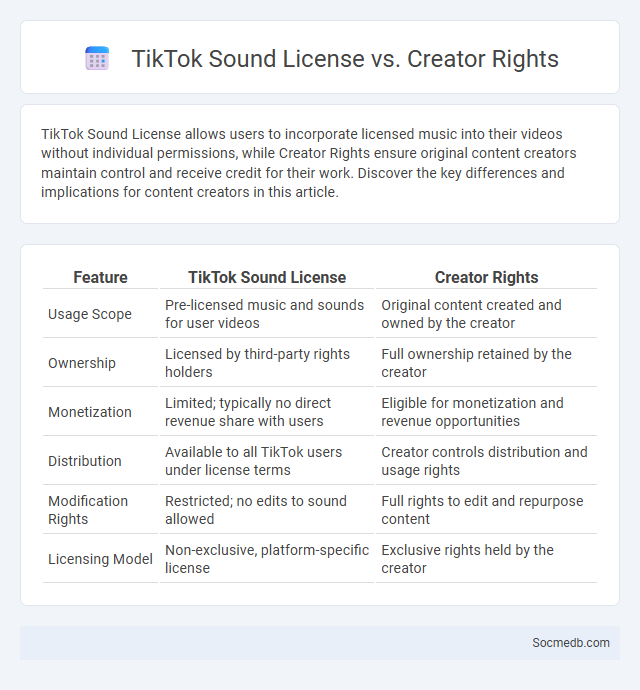
Photo illustration: TikTok Sound License vs Creator Rights
TikTok Sound License allows users to incorporate licensed music into their videos without individual permissions, while Creator Rights ensure original content creators maintain control and receive credit for their work. Discover the key differences and implications for content creators in this article.
Table of Comparison
| Feature | TikTok Sound License | Creator Rights |
|---|---|---|
| Usage Scope | Pre-licensed music and sounds for user videos | Original content created and owned by the creator |
| Ownership | Licensed by third-party rights holders | Full ownership retained by the creator |
| Monetization | Limited; typically no direct revenue share with users | Eligible for monetization and revenue opportunities |
| Distribution | Available to all TikTok users under license terms | Creator controls distribution and usage rights |
| Modification Rights | Restricted; no edits to sound allowed | Full rights to edit and repurpose content |
| Licensing Model | Non-exclusive, platform-specific license | Exclusive rights held by the creator |
Understanding TikTok Sound Licenses
TikTok sound licenses regulate the use of copyrighted audio tracks within videos on the platform, ensuring creators comply with intellectual property laws. These licenses allow users to legally incorporate popular songs, sound effects, and audio snippets into their content, provided the usage aligns with TikTok's terms. Understanding these licenses helps you avoid copyright infringements and maintain your account's good standing while boosting engagement through trending audio.
What are Creator Rights on TikTok?
Creator Rights on TikTok empower you to maintain control over your original content, ensuring protection against unauthorized use and reproduction. These rights include content ownership, the ability to monetize your videos, and access to analytics for performance insights. Upholding Creator Rights helps safeguard your creative work, enabling you to build a successful presence on TikTok.
Sound Copyright: Key Concepts Explained
Sound copyright protects original audio creations, including music, sound effects, and voice recordings, by granting creators exclusive rights to use and distribute their work on social media platforms. Understanding these rights helps you avoid infringement by properly licensing sounds or obtaining permission before sharing content online. Enforcement of sound copyright varies across platforms like YouTube and Instagram, requiring awareness of their specific policies to safeguard your content and respect others' intellectual property.
TikTok’s Approach to Licensed Audio
TikTok enables creators to legally use licensed audio tracks through partnerships with major music labels, offering access to a vast library of popular songs. This approach ensures copyright compliance while enhancing user experience by allowing Your content to feature trending sounds seamlessly. The platform's licensing agreements help protect artists' rights and promote original music discovery among millions of active users.
Distinguishing Creator Rights from Sound Copyright
Social media platforms require clear distinctions between creator rights and sound copyright to protect original content and ensure fair use. Creator rights refer to the ownership and control over content produced by individuals, while sound copyright specifically governs the legal protections of audio recordings. Understanding the nuances between these rights helps prevent unauthorized use and promotes respect for intellectual property in digital environments.
Legal Implications of Using Copyrighted Sound on TikTok
Using copyrighted sound on TikTok can lead to legal consequences including copyright infringement claims, resulting in account suspension or content removal. TikTok's licensing agreements do not cover all types of usage, so your unauthorized use of copyrighted music could attract penalties or lawsuits. To protect your content and comply with intellectual property laws, ensure you use sounds that are either royalty-free, licensed, or provided directly within TikTok's sound library.
TikTok’s Music Library: What’s Allowed for Users?
TikTok's Music Library offers users access to millions of licensed songs from major record labels including Universal Music Group, Sony Music, and Warner Music, ensuring a vast selection for content creation. Users are allowed to incorporate these tracks in their videos for personal, non-commercial use, with the platform handling royalty payments to rights holders. However, the library restricts usage for commercial purposes or promotions, requiring creators to obtain separate licenses if monetizing content beyond TikTok's standard guidelines.
Monetization and Ownership: Who Gets Paid?
Social media platforms generate significant revenue through advertising, sponsorships, and in-app purchases, but the distribution of earnings often favors the platform owners rather than content creators. Your content, while driving engagement and traffic, typically remains the property of the platform under their terms of service, limiting your control and profit potential. Monetization options like ad revenue sharing, brand partnerships, and fan subscriptions are available but often come with stringent eligibility criteria and platform-dependent payout structures.
Risks and Challenges for Creators Using Third-Party Audio
Creators using third-party audio on social media face significant risks including copyright infringement, content takedown, and potential account suspension. Unauthorized use of music or sound clips often triggers automated detection systems, leading to demonetization or removal of videos. Navigating licensing agreements and understanding platform policies remain crucial challenges to avoid legal repercussions and maintain audience trust.
Best Practices for Sound Usage on TikTok
Using clear, high-quality audio is essential for engaging TikTok content, as sound plays a crucial role in viewer retention and virality. You should leverage trending sounds and popular music legally by using TikTok's licensed audio library to ensure compliance with copyright rules. Optimizing your video's sound levels while minimizing background noise enhances your content's overall impact and keeps your audience focused on your message.
 socmedb.com
socmedb.com